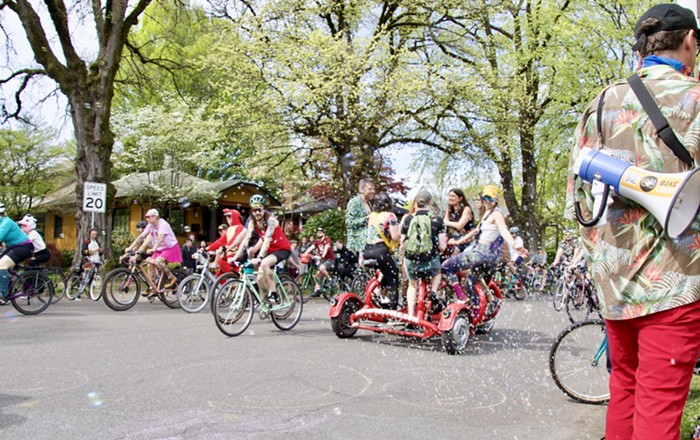E-bikes are dorky. They're great for getting up hills without breaking a sweat and, if done well, could help a lot of people start biking... but they weigh a ton, have huge batteries strapped to them, and just look rather clunky.
Which is why I'm totally in love with the Faraday, a gorgeous bike that was first designed as a concept prototype for the local Oregon Manifest challenge and is now launching into real-life production.

The Faraday was just one of many beautiful bikes this year at Oregon Manifest, a challenge that asks bike builders to create the "ultimate utility bike." Designer and Northeast Portland native Adam Vollmer spent nights and weekends for three solid months creating that first bike with a small team. "We built some scrappy prototypes, Frankenbikes with wires all hanging off," says Vollmer. "It looked like a bomb on wheels."
After the slick design got an avalanche of positive feedback at the challenge, Vollmer quit his job and is working to bring the Faraday into production. Right now you can only buy one of the first 250 Faraday bikes via Kickstarter for $3,500.
Details about how the bike works and plenty of drool-worthy photos below the cut. I rode it around the Pearl for a few minutes. The thing's a breeze.


This nifty thing on the right handlebar isn't a shifter, it's essentially the on-off button for the bike. You can push it forward to boost the electric assist and it will also have a tiny bar graph telling you how much battery life is left. Like most e-bikes, you can decide to turn the assist completely off, too.

The bike has a regular Shimano-geared internal hub in back and a leather bag hanging from the frame that's just to hold a wallet or phone. The leather parts and fenders are all made by a company in California.
Oregon Manifest was great for workshopping the design and the team made some changes to the design like making the batteries easier to replace and using wider, higher handlebars. The frames are US-built and are going to stay that way, says Vollmer. They're assembled where he now lives in the Bay Area.

One design issue for Faraday was the balance between having custom designs versus making the bike as easily repairable as possible. The LED lights integrated into the front and back of the frame, for example, are custom-built and made to last for years. If they break, you can remove the lights and get new ones from Faraday, but it's not the kind of thing they're going to carry in every bike store. "The reason a lot of e-bikes have these funky weird lights is because no one has made custom lights," says Vollmer. Same goes for the rack, which is custom-built but removable—Vollmer and team hope to have a bunch of options for racks to use on the bike, but it's not the kind of frame you can attach any off-the-shelf rack to. The back of the bike has braze-ons to which you can attach most any rear rack.
Here's the production bike and a clunkier prototype:

So. Anyone got an extra $3,500 for me?














